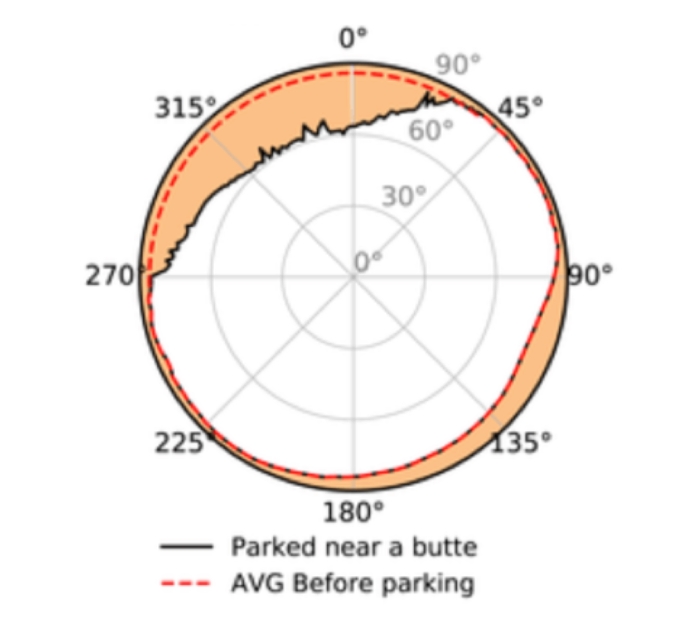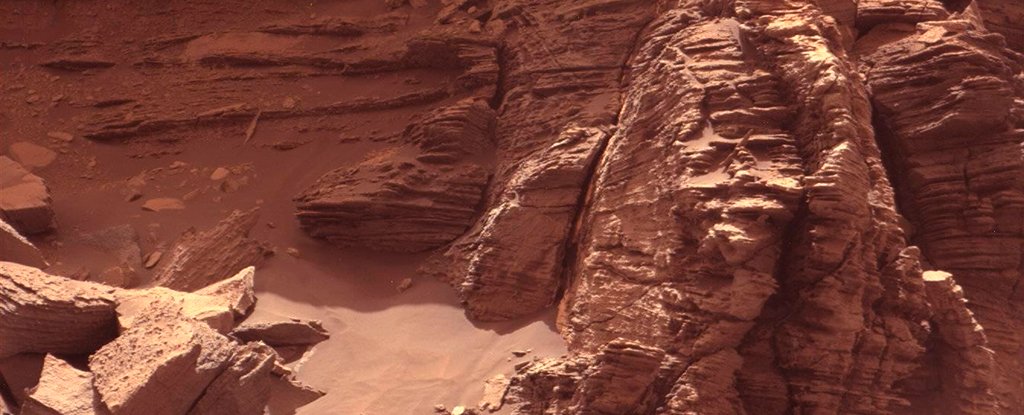Products You May Like
Mars is bombarded with radiation. Without a protective magnetic shield and a thick atmosphere like Earth’s, radiation from space has a nearly unimpeded path to the Martian surface. Our machines can roam around on the surface and face all that radiation with impunity.
But not humans. For humans, all that radiation is a deadly hazard.
How can any potential human explorers cope with that? Well, they’ll need shelter. And they’ll either have to bring it along with them or build it there somehow.
Or maybe not. Maybe they could use natural features as part of their protection.
A new study using data from Mars Science Laboratory (MSL) Curiosity has uncovered how Mars’ natural landscape features can provide some shelter from radiation. Specifically, it shows how Martian buttes provide protection from high-energy particles from space.
The study is titled “Directionality of the Martian Surface Radiation and Derivation of the Upward Albedo Radiation” and it’s published in Geophysical Research Letters. The lead author is Guo Jingnan from the University of Science and Technology of China.
When MSL Curiosity landed on the surface of Mars in 2012, it carried in its payload an instrument called the Radiation Assessment Detector (RAD).
RAD is about preparing for future human visits to Mars. It detects and measures harmful radiation on Mars that comes from the Sun and other sources. It can also assess the hazard that radiation poses to any microbial life that may be extant on Mars. RAD is about the size of a toaster and sits unobtrusively on Curiosity’s top surface.
One of the areas MSL studied with RAD is the Murray Buttes region. The Murray Buttes region is on lower Mt. Sharp in Gale Crater. Curiosity was there primarily to study geology, especially the sandstone features and a type of layering called “cross-bedding”.
But while there, RAD kept gathering data. And that data showed a drop in surface radiation.
MSL Curiosity spent 13 sols parked near a butte in the Murray Buttes area. It primarily conducted surface science and drilling operations while there. But RAD was also active, giving scientists a 13-day reading of radiation data in one location.
The RAD data showed that while near the butte, there was a reduction in radiation dose of about 5 percent. The research team also constructed a sky visibility map, showing that 19 percent of the sky was obscured when the rover was next to the butte.
This isn’t a scientific slam-dunk when it comes to protecting future human explorers from radiation, but it’s important data.
There’s more nuance to the data. While driving through the Murray Buttes area, Curiosity didn’t have an unobstructed view of the sky due to terrain features. So the team constructed the panoramic view of the sky from averages taken over several previous months to compare with the data gathered during the 13-sol parking.
There’s some approximations in those averages, but they’ll have to do.
 A sky map to illustrate the effect of the butte on radiation exposure. (Jingnan et al., GRL, 2021)
A sky map to illustrate the effect of the butte on radiation exposure. (Jingnan et al., GRL, 2021)
The dotted red line in the image above represents those approximations and averages.
RAD found something else, too. Radiation striking things, or people, on the surface of Mars originates from space. And most of the radiation striking a person or a piece of equipment comes directly from the sky.
But some of the radiation is albedo radiation, meaning it’s reflected off of the surface, striking objects from below. What did RAD find out about that?
It turns out that the same surface features that can offer protection from direct radiation can also increase reflected radiation. RAD showed that buttes can create an increase in this secondary, reflected radiation. That’s one of the complexities in understanding radiation on Mars.
The radiation dose on the surface of Mars isn’t consistent, but fluctuates. Heliospheric changes can affect it, as can the angle of sky that any explorers may be exposed to. A steeper angle means that radiation has to travel through more atmosphere, which changes the surface exposure.
Mars’ orbit changes its distance to the Sun, which also affects surface radiation. Lower altitudes will be exposed to less radiation than higher altitudes. And radiation isn’t a homogenous phenomenon: there are protons, alpha particles, ions of various elements, neutrons, and gamma rays.
Overall the study helps paint a more complete picture of the Martian radiation environment. There’s been lots of thought put into in-situ resource utilization on Mars. Shelter is a primary need for explorers on Mars, and if an advantage can be gained by using existing terrain features for protection, then those features will fit in a mission profile somewhere.
There’s already lots of talk about placing bases in lava tubes, where people would be protected by meters of Martian regolith. But astronauts can’t spend all their time there. They’ll have to venture out into the radiation.
Any mission to Mars involving humans will need layers and layers of contingencies. In the event of an emergency of some sort, it’ll be vital to keep astronauts’ radiation doses as low as possible.
In fact, the entire mission will be planned to keep annual exposure within limits. It’s not too difficult to imagine planetary explorers making use of whatever radiation shelter they can as they try to contend with an equipment breakdown or other mishap.
Detailed radiation maps that take into account sky exposure and terrain and anything else could save lives.
This article was originally published by Universe Today. Read the original article.
